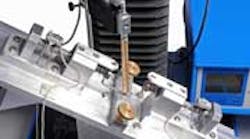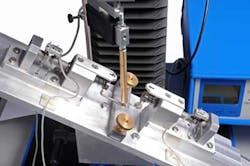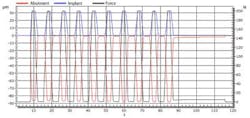This study was published in the November/December issue of The International Journal of Oral and Maxillofacial Implants (JOMI), the official journal of the Academy of Osseointegration (AO).
Background: Micromotion at the implant-abutment level has been identified as a major determinant of long-term implant success. Technical problems ranging from screw loosening to screw fracture may occur as a consequence of excessive micromotion. Different concepts for the design of the implant-abutment connection have been proposed in the past, which affect micromotion at the restorative interface as well as the stability of the abutments used. While initial micromotion depends predominantly on the fabrication accuracy achieved, long-term micromotion appears to be related primarily to wear phenomena at the implant-abutment interface. Despite the clinical importance of micromotion phenomena at the implant-abutment interface, no universally valid method for quantifying this phenomenon has been described.
Key point: It cannot be predicted that a certain type of abutment will always lead to a certain level of micromotion. Relative displacement of components occurs at varying magnitudes. However, strict adherence to manufacturers’ guidelines with respect to tightening torque may help reduce implant-abutment micromotion. Because micromovement occurs during the initial phase of loading, it may be prudent to routinely retighten the abutment screws, which might have lost preload.
Authors: Dr. Matthias Karl, Department of Prosthodontics, University of Erlangen-Nuremberg, Erlangen, Germany; Dr. Thomas D. Taylor, Department of Reconstructive Sciences, University of Connecticut, Farmington, Connecticut.
Purpose: Scientists aimed to establish a biomechanical approach to directly measure relative motion at the implant-abutment interface and to quantify micromotion in a variety of implant-abutment combinations. Geometry of the implant-abutment interface, fabrication method of the abutment, engagement of antirotational features, abutment material, tightening torque, and type of manufacturer (original, clone) were investigated.
Materials and methods: Implant-abutment assemblies were fixed in a universal testing machine at a 30-degree angle. A cyclic load of 200 N (Newtons) was applied to the specimens 10 times at a cross-head speed of 100N/s, while relative displacement between the implant and the abutment was quantified using extensometers. For five consecutive loading cycles per specimen, micromotion was recorded as a basis for statistical analysis. Comparative analysis was based on Welch tests.
Results: Investigated implant-abutment combinations produced a broad range of micromotion values. Researchers did not find perfect implant shoulder geometry or a perfect fabrication technique that would result in undetectable micromotion. The values for micromotion at the implant-abutment interface ranged from 1.52 µm to 94.00 µm (micrometers). Researchers found tightening torque significantly affected the level of micromotion when one specific abutment type was investigated. Implant shoulder design did not reveal a significant effect in all cases. Lack of engagement of antirotational features of the implants resulted in increased micromotion, regardless of the implant system investigated. Casting onto prefabricated gold cylinders resulted in abutments with significantly less micromotion compared to copy-milled stock abutments. Computer-aided design/computer-assisted manufacture (CAD/CAM) zirconia abutments showed less micromotion than CAD/CAM titanium abutments. Inconsistent levels of micromotion were recorded for CAD/CAM abutments coupled to proprietary and competing implant systems. In most cases, the CAD/CAM abutments performed as well as stock abutments. Great variations in micromotion were found with clone abutments and clone implant systems (Figures 1 and 2).
More information: For a complete copy of the study and the JOMI November/December Table of Contents, visit http://www.osseo.org/NEWIJOMI.html. To join AO and begin receiving JOMI (bimonthly) or obtain online access to JOMI, visit http://www.osseo.org/NEWmembershipApply.html.
PREVIOUS ISSUES OF AO, JOMI NEWS …
AO JOMI News: Implant-abutment interface configuration effects on dental implant therapy
AO, JOMI News: Accuracy of impression techniques, edentulous patients
About The International Journal of Oral & Maxillofacial Implants
This highly regarded, frequently cited journal integrates clinical and scientific data to improve methods and results of oral and maxillofacial implant therapy. It presents pioneering research, seminal studies, emerging technology, position papers, and consensus reports, as well as the many clinical and therapeutic innovations that ensue as a result of these efforts. The editorial board is composed of recognized opinion leaders in their respective areas of expertise and reflects the international reach of the journal. Under their leadership, JOMI maintains its strong scientific integrity while expanding its scientific influence within the field of dentistry. It is published by Quintessence Publishing and is the official journal of the Academy of Osseointegration.
About the Academy of Osseointegration
With 6,000 members in 70 countries around the world, the Academy of Osseointegration (AO) is recognized as the premier international association for professionals interested in implant dentistry. AO serves as a nexus where specialists and generalists can come together to evaluate emerging research, technology and techniques, share best practices, and coordinate optimal patient care using timely, evidence-based information. Follow AO on Facebook and Twitter.









